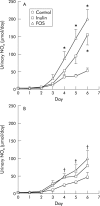Dietary fructo-oligosaccharides and inulin decrease resistance of rats to salmonella: protective role of calcium
- PMID: 15016747
- PMCID: PMC1774012
- DOI: 10.1136/gut.2003.023499
Dietary fructo-oligosaccharides and inulin decrease resistance of rats to salmonella: protective role of calcium
Abstract
Background: We have shown recently that rapid fermentable fructo-oligosaccharides (FOS) decreased resistance of rats towards salmonella. It is not known whether inulin (which is fermented more gradually) has similar effects or whether buffering nutrients can counteract the adverse effects of rapid fermentation.
Aims: To compare the effects of dietary inulin and FOS on resistance of rats to Salmonella enterica serovar Enteritidis and to determine whether calcium phosphate counteracts the effects of fermentation.
Methods: Male Wistar rats (n = 8 per group) were fed a human "Western style diet". Diets with 60 g/kg cellulose (control), FOS, or inulin had either a low (30 mmol/kg) or high (100 mmol/kg) calcium concentration. After an adaptation period of two weeks, animals were orally infected with 2 x 10(9) colony forming units of Salmonella enterica serovar Enteritidis. Colonisation of salmonella was determined by quantification of salmonella in caecal contents. Translocation of salmonella was quantified by analysis of urinary nitric oxide metabolites in time.
Results: Inulin and FOS decreased intestinal pH and increased faecal lactobacilli and enterobacteria. Moreover, both prebiotics increased the cytotoxicity of faecal water and faecal mucin excretion. Both prebiotics increased colonisation of salmonella in caecal contents and enhanced translocation of salmonella. Dietary calcium phosphate counteracted most of the adverse effects of inulin and FOS.
Conclusions: Both inulin and FOS impair resistance to intestinal infections in rats. This impairment is partially prevented by dietary calcium phosphate. The results of the present study await verification in other controlled animal and human studies.
Figures




Similar articles
-
Dietary fructo-oligosaccharides and lactulose inhibit intestinal colonisation but stimulate translocation of salmonella in rats.Gut. 2003 Nov;52(11):1572-8. doi: 10.1136/gut.52.11.1572. Gut. 2003. PMID: 14570725 Free PMC article.
-
Increasing the intestinal resistance of rats to the invasive pathogen Salmonella enteritidis: additive effects of dietary lactulose and calcium.Gut. 1997 Apr;40(4):497-504. doi: 10.1136/gut.40.4.497. Gut. 1997. PMID: 9176078 Free PMC article.
-
Dietary fructo-oligosaccharides dose-dependently increase translocation of salmonella in rats.J Nutr. 2003 Jul;133(7):2313-8. doi: 10.1093/jn/133.7.2313. J Nutr. 2003. PMID: 12840199
-
Protective effects of dietary lactulose and calcium phosphate against Salmonella infection.Scand J Gastroenterol Suppl. 1997;222:112-4. doi: 10.1080/00365521.1997.11720733. Scand J Gastroenterol Suppl. 1997. PMID: 9145462
-
Dietary calcium inhibits the intestinal colonization and translocation of Salmonella in rats.Gastroenterology. 1997 Aug;113(2):550-7. doi: 10.1053/gast.1997.v113.pm9247475. Gastroenterology. 1997. PMID: 9247475
Cited by
-
Dietary xylo-oligosaccharide stimulates intestinal bifidobacteria and lactobacilli but has limited effect on intestinal integrity in rats.BMC Res Notes. 2014 Sep 19;7:660. doi: 10.1186/1756-0500-7-660. BMC Res Notes. 2014. PMID: 25238818 Free PMC article.
-
Preventing or controlling periodontitis reduces the occurrence of osteonecrosis of the jaw (ONJ) in rice rats (Oryzomys palustris).Bone. 2021 Apr;145:115866. doi: 10.1016/j.bone.2021.115866. Epub 2021 Jan 27. Bone. 2021. PMID: 33515777 Free PMC article.
-
Dietary Inulin Increases Lactiplantibacillus plantarum Strain Lp900 Persistence in Rats Depending on the Dietary-Calcium Level.Appl Environ Microbiol. 2021 Apr 13;87(9):e00122-21. doi: 10.1128/AEM.00122-21. Print 2021 Apr 13. Appl Environ Microbiol. 2021. PMID: 33608291 Free PMC article.
-
Colonic transit time is related to bacterial metabolism and mucosal turnover in the gut.Nat Microbiol. 2016 Jun 27;1(9):16093. doi: 10.1038/nmicrobiol.2016.93. Nat Microbiol. 2016. PMID: 27562254
-
The Impact of Pre- and Probiotic Product Combinations on Ex vivo Growth of Avian Pathogenic Escherichia coli and Salmonella Enteritidis.Microorganisms. 2022 Jan 7;10(1):121. doi: 10.3390/microorganisms10010121. Microorganisms. 2022. PMID: 35056569 Free PMC article.
References
-
- Kasper H. Protection against gastrointestinal diseases—present facts and future developments. Int J Food Microbiol 1998;41:127–31. - PubMed
-
- Gibson GR, Roberfroid MB. Dietary modulation of the human colonic microbiota: introducing the concept of prebiotics. J Nutr 1995;125:1401–12. - PubMed
-
- Kleessen B, Hartmann L, Blaut M. Oligofructose and long-chain inulin: influence on the gut microbial ecology of rats associated with a human faecal flora. Br J Nutr 2001;86:291–300. - PubMed
-
- Gibson GR, Beatty ER, Wang X, et al. Selective stimulation of bifidobacteria in the human colon by oligofructose and inulin. Gastroenterology 1995;108:975–82. - PubMed
-
- Orrhage K, Nord CE. Bifidobacteria and lactobacilli in human health. Drugs Exp Clin Res 2000;26:95–111. - PubMed
MeSH terms
Substances
LinkOut - more resources
Full Text Sources
Medical
